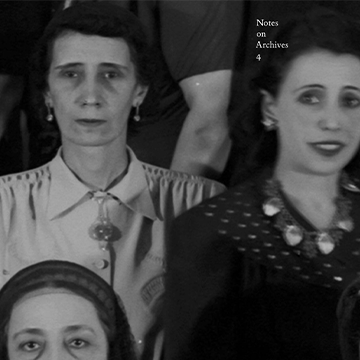Notes on Archives is a series of publications by artist Ines Schaber about archives and the practices we conduct in relation to them. Produced over the course of more than ten years, the publications feature a series of case studies, research, concrete projects, and reflections on the questions and problems that image archives pose today. The aim of the work is not to find or create another institutional archive per se, but to develop a practice in which the set of problems that archives produce is in fact part of the process one engages in.
Tag: Notes on Archives
Notes on Archives 4
In 2008, an exhibition opened at the Umm el-Fahem Art Gallery, Israel, that focused on the launching of a new on photographic archive: “Memories of a Place: The Photo-Archives graphic History of Wadi ‘Ara, 1903–2008.” Notably, the archive used a series of historical images from existing archives, often giving them different captions that retrieve lost histories in the area. This archive exemplifies the possibilities that can result from the critique of institutional image archives: that rethinking archival arrangements can bring to light legible traces of suppressed histories.
Notes on Archives 2
Culture Is Our Business considers the case of Willy Römer, who in 1919 took a photograph of the street battles in the media district of Berlin during the German Revolution. Circulating widely throughout the twentieth century, Römer’s photograph in 2004 came to be owned simultaneously by a number of archives. Among them were the commercial stock-image agency Corbis, founded by Bill Gates, and the Agentur für Bilder zur Zeitgeschichte (Agency for images on contemporary history), an independent organization established by photo historian Diethart Kerbs.
Notes on Archives 1
Obtuse, Flitting By, and in Spite of All—Image Archives in practice starts with the assumption that an archive today is not only a place of storage but also a place of production, where our relation to the past is materialized and where our present writes itself into the future. This book explores the difficulties for documentary and artistic practice in and with the archive, and revolves around four key questions: What is the relation between an image and language? What is an author or an owner of an image? What is missing in the archive? And what is an active archive?
Notes on Archives 3
In digital data banks, images travel more frequently from one archive to another than they did in analog archives. Sometimes images that are in the public domain are taken by commercial stock-image agencies and offered for sale. This is the case for a series of images of breaker boys in Pennsylvania that Lewis Hine made in the 1910s as part of his series on child labor. The images are both digitally available for free from the Library of Congress in Washington, D.C., and for a fee from Corbis, Bill Gates’s stock-image company, which offered them for sale until it ceased operations in 2016.
Notes on Archives 5
Unnamed Series features a succession of artworks provoked by photographs that art historian Aby Warburg had taken as part of his travels to the Hopi Indians in 1898. Warburg noted that the images should never be published, but in the 1990s, the Warburg Institute in London made the images available as part of a glossy hardcover book. The book circulates around a series of aspects that this famous encounter evokes.





